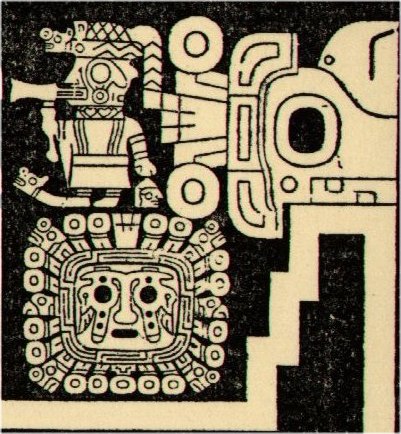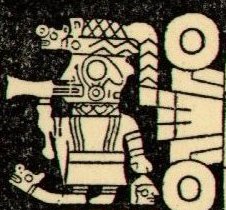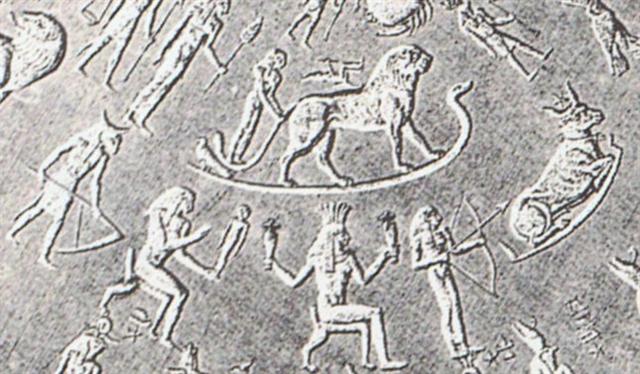|
TRANSLATIONS
This is the last page from the
link labelled 'number 548':
|
The
fundamental map of cosmos evidently contains the pattern 3 + 1,
and after 3 periods of calm Sun light comes a 4th period with drastic changes:

The
'helmet' of the great bird at right in the picture probably
illustrates these 3 periods of sun light. On top of the helmet there
is a design of 2 + 3 + 2 = 7. The two 'moon eyes' are each supported
by 2 and in the center between them is 3 fingers. These form the same type
of design as those at the top of
the great sun head below the figure blowing a trumpet. And the 2
'members' which are supporting the 'moon eyes' agree with how around the great
sun head each of the 17 'moon eyes' also have 2 'supporters'.
The 3
fingers in the center of the bird crown seem to correspond to the 3 fingers in the kai gesture:
|
 |
|
kai |
From
this comparison we can then proceed to the thumb in such glyphs as
Eb7-1:
|
 |
 |
 |
 |
|
Eb7-1 |
Eb7-2 (548) |
ua |
Rogo |
The
figure seems to be Rogo, and where his head should have been there are
what looks like waves, and the sign is a version of ua (turned a
quarter around). Only 2 waves are present, which - we can understand
- presumably refers to the domain of the Moon.
548
can be explained as
3 times 182.5 + ½, with
the fraction (½) illustrated as hipu. This pattern is also 3
+ 1, because the 4th period is not possible to measure, it is 'hidden
behind a dark cloth'.
The 4th period can be anything, it is an
unknown. To begin with it is a 'zero' time for the Sun, rather than
X, cfr at hahe. But somewhere the 'gazelle' wins the game and
Sun becomes 'imprisoned', 'barred'. He cannot be seen any more. The
figure blowing the horn appears to be a personification of the X
time. We
can see that he is 'growing' from the last of the 3 fingers in the crown of
the great bird. He is an extension of the 4th 'nail' added to
the 3rd.
He
has two 'moon' type of eyes, the main one above the smaller, and we know what
it means - Moon has 2 'seasons', the waxing period (the small eye)
and the waning period (the main eye) where Moon presumbaly is
pregnant (cfr the pau sign, like a nose, at right):

His
(her?) headgear has two layers, first one with a kava sign
and then, at the top, at net pattern. This net seems to be the end
result when moving upwards from the 'thumb' (the 4th 'nail'). The 4
wedges resemble a mea ke sign:
|
 |
 |
|
kava |
mea ke |
Perhaps the 4th 'nail' means the additional 100 needed to
reach 400 days. The 4 wedgemarks above could represent 4 times
100 nights as counted by the moon. The great bird head is placed
like an offering on the 'solstice platform' reached after a
climb in 3 steps. Then the path of the Sun leads straight down.
|
Next page:
|
So far these toki glyphs have been discussed:
 |
 |
 |
450 = 3 * 150 |
 |
 |
|
Ga1-29 (30) |
Ga1-30 |
Ga2-1 |
Eb7-1 |
Eb7-2 (548) |
|
94 |
95 |
96 = 64 + 32 |
547 |
3 * 182½ + ½ |
 |
 |
 |
 |
 |
 |
|
Qa6-26 |
Qa6-27 |
Qa6-28 |
Qa6-29 (234) |
Qa6-30 |
Qa6-31 |
|
180 |
181 = 64 + 234 / 2 |
182 |
 |
 |
 |
 |
|
*Qb6-23 |
*Qb6-24 (640) |
*Qb6-25 |
*Qb6-26 |
|
383½ = 13 * 29.5 |
384 |
384½ |
642 / 2 + 64 = 385 |
Tentatively it can be stated that toki hipu
indicates a dark time, while tagata toki
seems rather to indicate that light is still
'living'. The elbow ornament of Rogo in Eb7-1
apparently is a leg, presumably meaning that Sun
(who has only 1 'leg') now has 'emptied his hand'.
The other toki hipu (in *Qb6-25) is located as
the last part of the day beyond the kuhane
station Roto Iri Are.
I guess
the name Reitaga for Sirius is a mistake. It
should rather be the name of Venus in one of her 8
night long dark periods. Taga means a bag or
sack. When Venus is in 'the sack' she cannot be
seen, but Sirius is always there.
"... the name Ishtar is shared
by both Venus and Sirius ..." (Hamlet's Mill)
In the
round Dendera zodiac a sequence is beginning with a
god holding a 'digging stick' (henen) and the
5th figure is a bull (or cow) lying down. The idea
could therefore be to represent the 5 periods of the
Bull (because a mattock associates with a 'bull').
Above the sequence rules a great Lion. Both Bull and
Lion are pictured inside what could be boats
(there is water in the blue sky above us):

The
'bull' lying down is uplifted (reva) compared
with the preceding 4 figures,
probably meaning he is in the sky. The preceding 4th
person has a bow and arrows, maybe intending to
'bring him down'. If the bull has exhausted himself
(he is lying down) and left this earth (with his
spirit now being in the sky), only an arrow can
reach him.
The 2nd
figure obviously is holding a child (tamaiti)
in her hand.
The 'digging stick' has worked its magic. The 3rd figure has
the arms in a posture we can recognize as a sign of finality (cfr tagata rere). The first 3 persons
in this sequence could represent the 300 days of
Sun. In the headgear of the 'final' person we can count to 7, as in the
crown of the great bird:

The
standing bow-and-arrow figure will then correspond to the one
who is blowing the horn. We can guess it is
a female god, a garment
of the Moon. According to Hamlet's Mill she is
Satit and she is aiming her arrow at the cow
Sothis (Sirius). It must also be mentioned that
Puppis (the Stern of Argo) is part of
the Mesopotamian constellation of Bow and
Arrow.
|
|
"Sati (Satet) was one of
Khnum's two wives and as such a guardian goddess of the Cataracts.
According to Maspero her name signifies 'She who
runs like an arrow'. She is the Archer who lets fly the river's
current with the force and rapidity of an arrow.
She is represented as a woman wearing the white
crown of the South, flanked by two long horns. Like Neith she often
holds arrows and a bow in her hands.
She was worshipped in the extreme south of Egypt,
where her favourite abode was the island of Seheil. She gave her
name to the first nome of Upper Egypt which was called Ta Setet,
the 'Land of Sati'. Its capital was Abu, 'City of the
Elephant', the Elephantine of the Greeks, where Sati took her place
in the temple of Khnum in company with Anuket.
Anuket (Anquet), the Greek for which was
Anukis, was Khnum's second wife. She is represented as a woman
wearing a tall plumed crown. Her name seems to mean 'the Clasper' -
she who clasps the river bank and presses the Nile between the rocks
of Philae and Syene.
She was worshipped at Elephantine with Khnum and
Sati as a regional goddess of the Cataracts. She liked to reside on
the island of Seheil, which was consecrated to her."
(Larousse)
"Khnemu worked with Ptah in carrying out
the work of creation ordered by Thot, and is therefore one of the
oldest divinities of Egypt; his name means 'to mould', 'to model'.
His connexion with the primeval water caused him to
be regarded as the chief god of the inundation and lord of the
cataract at Elephantine. He dwelt in Annu,
but he was lord of Elephantine, and 'the builder of men, the maker
of the gods, and the father from the beginning'. Elsewhere he is
said to be 'Maker of things which are, creator of what shall be, the
beginning of beings, father of fathers, and mother of mothers'.
He supported the heaven upon its four pillars in the
beginning, and earth, air, sea, and sky are his handiwork. He is
depicted in the form of a man having a ram's head and horns
surmounted by plumes, uræi with disks,
etc.; in one hand he holds the sceptre and in the other the emblem of
life. Occasionally he is hawk-headed, and in one representation he
holds the emblem of water in each hand.
On a late bas-relief at Philæ
we find him seated at a potter's table upon which stands a human
being whom he has just fashioned."
(Book of the Dead) |
|

The first figure
in the sequence has a ram's head and presumably he is meant to
illustrate Khnum. He 'fashions' the child who is the main
figure in next 'glyph'.
I guess it is
Anuket who holds the child. Presumably she is also the person in
the 3rd 'glyph'. The Nile has two banks and the eastern bank
should correspond to birth, because the western is associated with death.
The two banks thus resemble the two faces of the moon.
Satit will
then perform the role of the sun. She has only 1 'glyph' and the
arrow is an instrument of the sun (his rays).
The cow in the sky
resides in a kind of boat with 2 ends, but the Lion stands in a
vessel with only 1 figure head. It is a snake. The Sothis cow
is connected with the moon and the Lion with the sun.
|

Sirius, the 'Arrow-Star', is named
mulKAK.SIDI
(gag.si.sa) and The Bow is
mulBAN
(with
mul
meaning 'star').
In
China the arrow is shorter, ending before Sirius
(The Celestial Jackal, T'ien-lang).

Evidently the Chinese for some reason took away
the arrow completely at a later stage:

All
three pictures are from Hamlet's Mill.
|
For
the Egyptians Sirius was responsible for the yearly
rising of the Nile. There was a kind of connection
between liquids and Sirius:
"... Pliny wants to assure us that
'the whole sea is conscious of the rise of that
star, as is most clearly seen in the Dardanelles,
for sea-weed and fishes float on the surface, and
everything is turned up from the bottom'. He also
remarks that at the rising of the Dog-Star the wine
in the cellars begins to stir up and that the still
waters move ..." (Hamlet's Mill)
The
Deluge is caused by Sirius, we can guess, and the
location must be where the 'hour-glass' is turned
upside down. One example of sea-weed is iri-are
(as in Roto Iri Are, the 13th kuhane
station):
|
Roto 1.
Inside. 2. Lagoon (off the coast, in the
sea). 3. To press the juice out of a
plant; taheta roto pua, stone
vessel used for pressing the juice out
of the pua plant, this vessel is
also just called roto. Roto o
niu, east wind. Vanaga.
1. Marsh, swamp, bog;
roto nui, pond; roto iti,
pool. 2. Inside, lining; o roto,
interior, issue; ki roto, within,
into, inside, among; mei roto o mea,
issue; no roto mai o mea,
maternal; vae no roto, drawers.
Churchill. |
| Iri
1. To go up; to go in a
boat on the sea (the surface of which
gives the impression of going up from
the coast): he-eke te tagata ki ruga
ki te vaka, he-iri ki te Hakakaiga,
the men boarded the boat and went up to
Hakakainga. 2. Ka-iri ki puku
toiri ka toiri. Obscure expression
of an ancient curse. Vanaga.
Iri-are, a
seaweed. Vanaga. |
If we
move across the equator the sky will be turned
upside down. Sirius could be the star to look for when
the 'season of land' turns into a 'season of sea'.
The 12th kuhane station is Hatinga Te Kohe, the time when the 'staff is broken'. The sky roof
will collapse and darkness will engulf us.
Hatinga Te Kohe appears to be a mirror image of
the 'arrow of light'.
|
Canis
Major is very far down compared with the path of the Sun:

The
Bow has 7 stars according to this map. The Arrow
needs 2. We can guess why a Chinese emperor would
avoid an arrow when he performed the ceremony of
drawing the bow. 9 is a 'death' symbol for the Sun (which the
emperor personified). 9 means he will be 'turned
upside down'.
The
map has Orion formed like an hour-glass. Between its
upper and lower parts there is a small opening in
the midst of which there is a star (Alnilam).
Between Bow and Arrow and Orion we can observe a
constellation with 13 stars forming a ring (or
hole). 13 as in Roto Iri Are.
The picture of the Chinese star chart comes from
Hamlet's Mill.
|
Alnilam is only briefly mentioned in Allen:
"Alnilam, Anilam,
Ainilam, and Alnihan are from Al
Nithām, or Al Nathm, the String of
Pearls, or, as Recorde said, the Bullions set in the
middle of Orion's Belt.
It portended fleeting public honors
to those born under its influence.
The spectrum is Sirian, and the star
recedes from us at the rate of about 16½ miles a
second.
It is the central one of the Belt,
culminating on the 25th of January."
The
word bullion made me associate to bull. But English
Etymology:
"Bullion ... precious metal in
the mass ... Rom. *bulliōnem
boiling, f. L. bullīre
boil ..."
It
makes sense. When heat makes contact with water the
result will be boiling. The Belt of Orion lies
across the celestial equator.
Boiling causes everything to churn around and what
is at bottom will suddenly be on the surface:
.. the whole sea is conscious of the rise of that
star, as is most clearly seen in the Dardanelles,
for sea-weed and fishes float on the surface, and
everything is turned up from the bottom ...
Indeed it should portend only a 'fleeting public
honor', because in an instant it once again will be
submerged, no longer at the top.
|
|